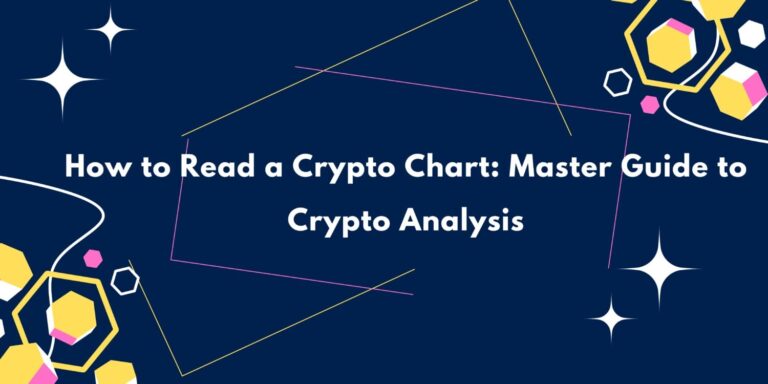Reading crypto charts allows traders to spot investment opportunities and make better decisions by analyzing chart patterns, trends, and price movements. These charts also help us understand the market trends. This article aims to provide information on How to Read a Crypto Chart: Master Guide to Crypto Analysis.
What are crypto charts?
A cryptocurrency chart is a visual aid that traders may use to identify patterns or potential future changes in the market. It shows data regarding cryptocurrency price fluctuations and trading volume. Crypto charts provide additional information to help traders make decisions by analyzing historical trading data and chart patterns that frequently predict future price movements.
What are the types of charts?
Charts that display the historical movement of an asset’s price can be broadly classified into three categories:
Line Charts
The most basic chart used in crypto trading is the line chart. Over a certain time period, a line connects each closing price. This kind of chart may be used to identify long-term price changes and broad patterns. However, it does not provide comprehensive information regarding intraday price movements.
This type of chart is best for beginners who don’t want to go into detail but just want to be aware of the market’s direction.
Bar Charts
Bar charts offer more detailed information than line charts. Every bar indicates the opening, closing, high, and low prices for a certain time period (such as a day or an hour). Bar charts are more detailed than line charts but not as detailed as Candlestick charts.
Candlestick Charts
The price at the top of the bar represents the highest price within that time period, while the price at the bottom displays the lowest. The opening and closing prices are shown by small horizontal lines on the left and right of the bar, respectively. Bar charts are helpful for traders to examine the direction and intensity of price changes over time.
Since they present the same data as bar charts in a more comprehensible style, candlestick charts may be the most well-liked and often used in Crypto trading.
Each candlestick represents a certain time period and displays the opening, closing, high, and low prices. Thanks to the candlestick’s colored body, which is normally green for up periods and red for down periods, it is simple to determine if the price ended higher or lower than it opened. This offers the most comprehensive form and details of the market.


How to read crypto charts for beginners
Start with choosing a cryptocurrency chart.
Choose the cryptocurrency chart that you wish to study first. Please pay attention to cryptocurrencies with large trading volumes and liquidity since they have more consistent price data. Seek trustworthy websites for charting or trading that provide access to many cryptocurrencies.
Key Crypto Chart Components: Price Action, Volume, and Timeframes
The time intervals shown on a Bitcoin chart are called timeframes. Traders get access to a broader range of timeframes, from one minute to one month or longer.
Shorter timescales provide a closer look at market movements, while longer ones offer a broader perspective. For example, traders may use a short-period chart to identify a short-term trend or momentum, while a long-time frame chart may show long-term market trends.
Volume is the total amount of cryptocurrency that is exchanged in a specific period of time. It is an important indicator since it provides information about how strong a trend is.
High trading volume indicates a strong market trend, while low volume may imply a volatile market. Traders may use volume data to confirm or deny price patterns.
The phrase “price action” refers to the gradual fluctuations in crypto pricing. It comprises support and resistance levels, trend lines, and chart patterns.
Price action analysis is a tool traders use to identify trading opportunities based on price fluctuations. A trader may, for example, look for a breakout from a resistance level or trend line, which signals that the price may increase further.
Understanding the Indicators
You may discover hundreds of various indicators on the charting program. The purpose of indicators is to assist you in determining the attitude and trajectory of the cryptocurrency market. The ones that traders apply the most frequently are highlighted in the list below: –
A moving average finds trends and “smooths out” pricing data. They plot the average price over a given period.
There are two primary categories of moving averages:
The Simple Moving Average (SMA) determines the average price over a predetermined number of equally spaced periods.
Exponential Moving Average (EMA): The EMA gives more weight to current prices and is more sensitive to market changes.


- Relative Strength Index(RSI)
One well-liked momentum oscillator that gauges the velocities and variations in market movements is the RSI. Its range is 0 to 100 and is used to find “overbought” and “oversold” market conditions.
A value below 30 indicates that the cryptocurrency is oversold, whereas a rating above 70 indicates overbought, suggesting a possible price correction. However, The price movement frequently occurs much after it is determined to have been “overbought” or “oversold.”


- MACD (Moving Average Convergence Divergence)
The MACD is a momentum indicator that follows trends. Its two lines are the signal line and the MACD line. The smoothed average of the MACD line is the signal line, while the MACD line shows the difference between two exponential moving averages. MACD and signal line crossovers can produce buy or sell signals.


The Fibonacci retracement tool uses horizontal lines and Fibonacci ratios to determine possible levels of support and resistance. These ratios come from a series of numbers in mathematics, where each number is equal to the sum of the two numbers that came before it. The tricky part of using the Fibonacci tool is figuring out where on a chart to put it.


A basic moving average and two standard deviation bands drawn below and above the moving average make up a Bollinger Band. They indicate how volatile prices are. A price breakout outside the bands could point to a strong momentum or a trend reversal, while a price inside the bands indicates a range-bound market.
The elements and purpose of Bollinger Bands are broken down as follows:
- Middle Band: The middle band, or baseline, usually a 20-period SMA, is a simple moving average.
- Upper Band: This is the upper bound or resistance level with a greater likelihood of a price reversal or selling pressure.
- Lower Band: This stands for the lower bound or support level, where there is often more buying pressure and a greater likelihood of prices rebounding.
Bollinger Bands are useful for locating zones of resistance and support. They can assist in identifying price breakouts and expanding and contracting in response to market volatility.


Identifying Trends and Patterns
When trading cryptocurrency, there are about 30 to 40 predictable trends. Finding chart patterns is essential to technical analysis, even if you are only expected to be an expert at some. This helps traders predict future price moves. The following are typical patterns to search for:
Head-and-shoulders pattern:
This reversal pattern might indicate a shift in the trend’s direction. It comprises two lower peaks (shoulders) and one higher peak (head).
Formation:
Left shoulder: A high point that is thereafter dropped.
Head: A more significant peak that is followed by a fall.
Right shoulder: A second peak about as high as the left, then it declines.
This pattern usually denotes a bearish reversal after an upswing. A break beneath the neckline validates the pattern.


Doubles Tops and bottoms
The reversal patterns, including the double tops and bottoms, signal a shift in the direction of the trend.
Formation:
Double top: After an upswing, these formations are defined by two peaks at about the same level.
Double bottom: A downturn is followed by two troughs at almost the same level.
Double top: The price peaks, retraces, climbs to a comparable peak and then falls.
Double bottom: The price reaches a low point, bounces back, drops to a lower low point once again, and finally rises.
A double top indicates a bearish reversal, while a double bottom indicates a bullish reversal. A double top is confirmed when the price breaks above the resistance level (for double bottoms) or below the support level (for double tops).


Triangles
Triangles are continuation patterns, meaning that when the pattern is finished, the price will move in the same direction. Triangles come in three primary kinds: symmetrical, descending, and ascending.
Ascending triangle
Triangle patterns that ascend can also resolve in either way. Similar to its descending counterpart, you should never disregard your protection measures in the event that a transaction turns out poorly. Ascending triangle formations are, however, widely regarded as Bullish patterns.The stock should ideally show a sequence of higher lows developing.


Descending triangle
The traditional form of this pattern consists of a flat or horizontal support line and a sloping trend line. Once the price bounces off the support level at least twice, a pattern begins to take shape. Following the conclusion of a downward retracement, the pattern is completed. The slide is strongly led by negative momentum and starts with a downward breakthrough from the support. This denotes a negative tendency. A break below the support line validates the pattern.


Symmetrical triangle
In technical analysis of financial markets, the symmetrical triangle is a frequently seen pattern.When the price of a security consolidates, two converging trend lines with opposing slopes are produced, forming symmetrical triangles. The distance between the original high and low applied to the breakout or breakdown point determines a symmetrical triangle’s breakout or breakdown objectives. The price oscillates between converging upward and downward trend lines. The pattern is validated if there is a deviation from the current trend.


Conclusion
Crypto charts can help you maximise your returns from your crypto investment and fully exploit the investment opportunity. If you stay consistent and master the patterns, terminology, and charts, your trading account will grow, and trading will become intuitive. Although cryptocurrency trading has the potential to be very rewarding, there is a chance that you might lose all of your money very fast, especially if there is high leverage. We would suggest you to use a virtual account to remove risk and practice trading.
Frequently Asked Questions
What typical errors should novices steer clear of while examining cryptocurrency charts?
Beginners should focus only a little on indicators, disregarding volume and failing to modify their strategy in response to market shifts. These elements are necessary to ensure correct chart interpretations and good trading choices.
Which one is The Best Charting Software For Crypto Trading?
Trading cryptocurrencies without a chart is not advised. Analyzing the trend, keeping an eye on chart patterns, and identifying support and resistance zones are crucial. Without a chart, trading cryptocurrency is akin to gambling, as most deals are based only on speculation or recommendations from other traders.
Where to see Live crypto charts?
Live crypto charts can be analyzed on platforms like Coinmarketcap, TradingView, Binance, etc.



